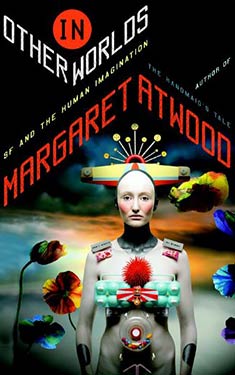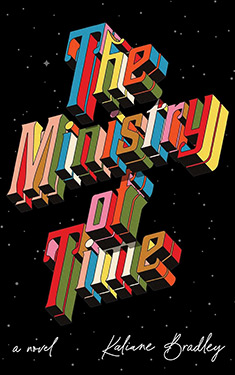
Added By: justifiedsinner
Last Updated: Administrator
In Other Worlds: SF and the Human Imagination
| Author: | Margaret Atwood |
| Publisher: |
Doubleday, 2011 |
| Series: | |
|
This book does not appear to be part of a series. If this is incorrect, and you know the name of the series to which it belongs, please let us know. |
|
| Book Type: | Non-Fiction |
| Genre: | Science-Fiction |
| Sub-Genre Tags: | |
| Awards: | |
| Lists: | |
| Links: |
|
| Avg Member Rating: |
|
|
|
|
Synopsis
Note: The electronic version of this title contains over thirty additional, illuminating eBook-exclusive illustrations by the author.
At a time when speculative fiction seems less and less far-fetched, Margaret Atwood lends her distinctive voice and singular point of view to the genre in a series of essays that brilliantly illuminates the essential truths about the modern world. This is an exploration of her relationship with the literary form we have come to know as "science fiction,” a relationship that has been lifelong, stretching from her days as a child reader in the 1940s, through her time as a graduate student at Harvard, where she worked on the Victorian ancestor of the form, and continuing as a writer and reviewer.
This book brings together her three heretofore unpublished Ellmann Lectures from 2010: "Flying Rabbits," which begins with Atwood's early rabbit superhero creations, and goes on to speculate about masks, capes, weakling alter egos, and Things with Wings; "Burning Bushes," which follows her into Victorian otherlands and beyond; and "Dire Cartographies," which investigates Utopias and Dystopias. In Other Worlds also includes some of Atwood's key reviews and thoughts about the form. Among those writers discussed are Marge Piercy, Rider Haggard, Ursula Le Guin, Ishiguro, Bryher, Huxley, and Jonathan Swift. She elucidates the differences (as she sees them) between "science fiction" proper, and "speculative fiction," as well as between "sword and sorcery/fantasy" and "slipstream fiction." For all readers who have loved The Handmaid's Tale, Oryx and Crake, and The Year of the Flood, In Other Worlds is a must.
Excerpt
Introduction
"I'm a fifty-three-year-old writer who can remember being a ten-year-old writer and who expects some day to be an eighty-year-old writer."
- Octavia Butler
In Other Worlds is not a catalogue of science fiction, a grand theory about it, or a literary history of it. It is not a treatise, it is not definitive, it is not exhaustive, it is not canonical. It is not the work of a practicing academic or an official guardian of a body of knowledge. Rather, it is an exploration of my own lifelong relationship to a literary form, or forms, or sub-forms, both as reader and as writer.
I say "lifelong," for among the first things that I read and also wrote might well have the SF initials attached to them. Like a great many children before and since, I was an inventor of other worlds. Mine were rudimentary, as such worlds are when you're seven, but they were emphatically not of this earth, which seems to be one of the salient features of SF. I wasn't much interested in Dick and Jane as a child. They did not convince me. Saturn was more my speed, and other realms even more outlandish. Several-headed man-eating marine life seemed more likely, somehow, than Spot and Puff.
Our earliest loves, like revenants, have a way of coming back in other forms; or, to paraphrase Wordsworth, the child is mother to the woman. To date -- and as what I am pleased to think of as an adult -- I have written three full-length fictions that nobody would ever class as sociological realism: The Handmaid's Tale, Oryx and Crake, and The Year of the Flood. Are these books "science fiction," I am often asked? Though sometimes I am not asked, but told: I am a silly nit or a snob or a genre traitor for dodging the term, because these books are as much "science fiction" as 1984 is, whatever I might say. But is 1984 as much "science fiction" as The Martian Chronicles, I might reply? I would answer not, and therein lies the distinction.
Much depends on your nomenclatural allegiances, or else on your system of literary taxonomy. Back in 2008 I was talking to a much younger person about "science fiction." I'd been asked by the magazine New Scientistto answer the question, "Is science fiction going out of date?" But then I realized that I couldn't make a stab at the answer because I didn't really grasp what the term "science fiction" meant any more. Is this term a corral with real fences that separate what is clearly "science fiction" from what is not, or is it merely a shelving aid, there to help workers in bookstores place the book in a semi-accurate or at least lucrative way? If you put skin-tight black or silver clothing on a book cover along with some jet-like flames and/or colourful planets, does that make the work "science fiction"? What about dragons and manticores, or backgrounds that contain volcanoes or atomic clouds, or plants with tentacles, or landscapes reminiscent of Hieronymus Bosch? Does there have to be any actual science in such a book, or is the skin-tight clothing enough? These seemed to me to be open questions.
This much younger person - let's call him Randy, which was in fact his name - did not have a hard and fast definition of "science fiction," but he knew it when he saw it, kind of. As I told New Scientist, "For Randy - and I think he's representative - sci-fi does include other planets, which may or may not have dragons on them. It includes the wildly paranormal--not your aunt table-tilting or things going creak, but shape-shifters and people with red eyeballs and no pupils, and Things taking over your body." Here I would include such items as Body Snatchers--if of extra-terrestrial rather than folkloric provenance--and Pod People, and heads growing out of your armpits, though, as I've said, I'd exclude common and garden variety devils, and demonic possession, and also vampires and werewolves, which have literary ancestries and categories all their own.
As I reported in my New Scientistarticle, for Randy Sci-fi includes, as a matter of course, space ships, and Mad Scientists, and Experiments Gone Awfully Wrong. Plain ordinary horror doesn't count -- chain-saw murderers and such. Randy and I agreed that you might meet one of those walking along the street. It's what you definitely would not meet walking along the street that makes the grade as SF. Randy judged such books in part by the space-scapes and leathery or silvery outfits on their covers, which means that my speculations about jacket images are not entirely irrelevant. As one friend's child put it, "Looks like milk, tastes like milk - it IS milk!" Thus: looks like science fiction, has the tastes of science fiction -- it IS science fiction!
Or more or less. Or kind of. For covers can be misleading. The earliest mass-market paperbacks of my novels, The Edible Woman and Surfacing, had pink covers with gold scrollwork designs on them and oval frames with a man's head and a woman's head silhouetted inside them, just like valentines. How many readers picked these books up, hoping to find a Harlequin Romance or reasonable facsimile, only to throw them down in tears because there are no weddings at the ends?
Then there was the case of the former Soviet Union. No sooner did the Wall come down in 1989 than pornography flooded across the one-time divide. Porn had hitherto been excluded in favour of endless editions of the classics and other supposed-to-be-good-for-you works, but forbidden fruit excites desire, and everyone had already read Tolstoy, a lot. Suddenly the publishers of serious literature were hard pressed. Thus it was that The Robber Brideappeared in a number of Soviet-bloc countries with covers that might be described as - at best - deceptive, and - at worst - as a Eurotrash slutfest in flagranto. How many men in raincoats purchased the Robber Bride edition sporting a black-satin-sheathed Zenia with colossal tits, hoping for a warm one-handed time in a back corner, only to heave it into the trash with a strangled "Foiled Again!" curse? For the Zenia in my book performs what we can only assume is her sexual witchery offstage.
Having thus misled readers twice - inadvertently -- by dint of book covers and the genre categories implied by them, I would rather not do it again. I would like to have space creatures inside the books on offer at my word-wares booth, and I would if I could: they were, after all, my first childhood love. But, being unable to produce them, I don't want to lead the reader on, thus generating a frantic search within the pages - Where are the Lizard Men of Xenor? -- that can only end in disappointment.
My desire to explore my relationship with the SF world, or worlds, has a proximate cause. In 2009, I published The Year of the Flood, the second work of fiction in a series exploring another kind of "other world" - our own planet in a future. (I carefully say a future rather than the future, because the future is an unknown: from the moment now, an infinite number of roads lead away to "the future," each heading in a different direction.)
The Year of the Flood was reviewed, along with its sibling, Oryx and Crake,by one of the reigning monarchs of the SF and Fantasy forms, Ursula K. LeGuin. Her 2009 Guardian article began with a paragraph that has caused a certain amount of uproar in the skin-tight clothing and other-planetary communities - so much so that scarcely a question period goes by at my public readings without someone asking, usually in injured tones, why I have forsworn the term "science fiction," as if I've sold my children to the salt mines.
Here are LeGuin's uproar-causing sentences :
"To my mind, The Handmaid's Tale, Oryx and Crake and now The Year of the Flood all exemplify one of the things science fiction does, which is to extrapolate imaginatively from current trends and events to a near-future that's half prediction, half satire. But Margaret Atwood doesn't want any of her books to be called science fiction. In her recent, brilliant essay collection, Moving Targets, she says that everything that happens in her novels is possible and may even have already happened, so they can't be science fiction, which is 'fiction in which things happen that are not possible today.' This arbitrarily restrictive definition seems designed to protect her novels from being relegated to a genre still shunned by hidebound readers, reviewers and prize-awarders. She doesn't want the literary bigots to shove her into the literary ghetto."
The motive imputed to me is not in fact my actual motive for requesting separate names. (If winning prizes were topmost on my list, and if writing such books would guarantee non-wins, my obvious move would be to just avoid writing them.) What I mean by "science fiction" is those books that descend from H.G. Wells's War of the Worlds, which treats of an invasion by tentacled, blood-sucking Martians shot to earth in metal canisters - things that could not possibly happen - whereas, for me, "speculative fiction" means plots that descend from Jules Verne's books about submarines and balloon travel and such - things that really could happen, but just haven't completely happened yet. I would place my own books in this second category: no Martians. Not because I don't like Martians, I hasten to add: they just don't fall within my skill set. Any seriously-intended Martian by me would be a very clumsy Martian indeed.
In a public discussion with Ursula LeGuin in the fall of 2010, however, I found that what she means by "science fiction" is speculative fiction about things that really could happen, whereas things that really could not happen she classifies under "fantasy." Thus, for her--as for me--dragons would belong in fantasy, as would, I suppose, the film Star Wars and most of the TV series Star Trek. Mary Shelley's Frankenstein might squeeze into LeGuin's "science fiction," because its author had grounds for believing that electricity actually might be able to reanimate dead flesh. And War of the Worlds? Since people thought at the time that intelligent beings might live on Mars, and since space travel was believed to be possible in the imaginable future, this book might have to be filed under LeGuin's "science fiction." Or parts of it might. In short, what LeGuin means by "science fiction" is what I mean by "speculative fiction," and what she means by "fantasy" would include what I mean by "science fiction." So that clears it all up, more or less. When it comes to genres, the borders are increasingly undefended, and things slip back and forth across them with insouciance.
Bendiness of terminology, literary gene-swapping, and inter-genre visiting has been going on in the SF world--loosely defined--for some time, if not forever. For instance, in a 1989 essay called "Slipstream," veteran SF author Bruce Sterling deplored the then-current state of Science Fiction and ticked off its writers and publishers for having turned it into a mere "category" - a "self-perpetuating commercial power-structure, which happens to be in possession of a traditional national territory: a portion of bookstore rack space." A "category," says Sterling, is distinct from a "genre," which is "a spectrum of work united by an inner identity, a coherent aesthetic, a set of conceptual guidelines, an ideology if you will."
Sterling defines his term "Slipstream"--so named, I suppose, because it is seen as making use of the air currents created by Science Fiction proper--in this way:
"I want to describe what seems to me to be a new, emergent 'genre,' which has not yet become a 'category.' This genre is not 'category' SF; it is not even 'genre' SF. Instead, it is a contemporary kind of writing which has set its face against consensus reality. It is fantastic, surreal sometimes, speculative on occasion, but not rigorously so. It does not aim to provoke a 'sense of wonder' or to systematically extrapolate in the manner of classic science fiction. Instead, this is a kind of writing which simply makes you feel very strange; the way that living in the late twentieth century makes you feel, if you are a person of a certain sensibility."
His proposed list of slipstream fictions covers an astonishing amount of ground, with works by a wide assortment of people, many of them considered to be "serious" authors - from Kathy Acker and Martin Amis to Salman Rushdie, José Saramago, and Kurt Vonnegut. What they have in common is that the kinds of events they recount are unlikely to occur. In an earlier era, these "slipstream" books might all have been filed under the heading of "traveler's yarn" - for example, Herodotus's accounts of monopods and giant ants or medieval legends about unicorns, dragons, and mermaids. Later they might have turned up in other collections of the marvelous and uncanny, such as Des Knaben Wunderhorn, or - even later - the kind of You-won't-believe-this hair-raiser to be found in assortments by M.R. James or H.P. Lovecraft, or - occasionally - R.L. Stevenson.
But surely all draw from the same deep well: those imagined other worlds located somewhere near our everyday one. Science Fiction, Speculative Fiction, Sword and Sorcery Fantasy, and Slipstream Fiction: all of them might be placed under the same large "wonder tale" umbrella.
This book is arranged in three sections. The first section is a personal history of sorts. Its three chapters have as their genesis the Ellman Lectures I delivered at Emory University in Atlanta, Georgia, in the fall of 2010. The first chapter, "Flying Rabbits," explores my involvement with SF and superheroes as a child, with some thoughts on the deep origins of such superhero features as body-hugging outfits, otherworldly origins, double identities, and flying. The second chapter, "Burning Bushes," is concerned with my undergraduate interest in ancient mythologies, which both pre-date and inform SF. It then goes on to speculate on the differences between realistic fictions and the other kinds, and on the positive and negative capabilities of each.
The third chapter, "Dire Cartographies," is partly about my unfinished PhD thesis, which was about a number of 19th and early 20th century fictions I collected together under the label, "the metaphysical romance." What intrigued me about the books I was studying were the supernatural female figures in them, the realms they inhabited, and the Wordsworthian/Darwinian split in the visions of nature they represented. These explorations led me to utopias and dystopias, of which the Victorian non-realists and those who continued to write in their traditions were very fond. "Dire Cartographies" is thus also about the three novels I myself have so far written that might be viewed as a continuation of these traditions.
The second section gathers together some of the many pieces I have written about specific works of SF over the years. Some are reviews, some are introductions, others were originally radio talks. Why did I choose these particular works of SF to write about, you may wonder? But I didn't choose them, exactly: in each case, someone else asked me to write about them, and I was unable to resist.
The third section is called "Five Tributes," and it is more or less what it says. These pieces were selected from among the many such that I have written over the decades, and each draws on recognizable memes from the genre. Four are self-contained miniatures, but the last one - "The Peach Women of A'aa" - is from my novel, The Blind Assassin, one of whose main characters is a writer of science fiction during the early years of what is referred to as the golden age.
So that is what this book is about. It's about my somewhat tangled personal history with SF, first as a child, then as an adolescent, then as a one-time student and academic; then as a reviewer and commentator; and then, finally, as a composer.
But where does all of this come from - the reading, the writing, the engagement, and especially the wilder storms on the wilder seas of invention? Everyone wants to know this about writers: What is your inspiration, what put you up to it? They're never satisfied with such explanations as "Because it was there" or "I don't know what came over me." They want specifics.
So let me try this:
As a young child, living briefly in the winter of 1944-5 in an old house in Sault Ste. Marie, I used to get up very early in the morning before anyone else was awake and go to the cold but spacious attic, where in a state of solipsistic bliss I would build strange habitations and quasi-people with a bunch of sticks and spools called "Tinker Toy." What I really wanted to make was the windmill pictured on the box, but my set didn't have the necessary parts, and it was wartime, and I was unlikely to ever possess the missing items.
Some say that the art one makes as an adult supplies the absence of things longed for in childhood. I don't know whether or not this is true. If I'd been able to create that windmill, would I have become a writer? Would I have become a writer of SF? We'll never know the answer to that question, but it's one theory.
Meanwhile - in gravely altered form - here is the windmill. I hope you have as much fun with it as I have had.
Copyright © 2011 by Margaret Atwood
Reviews
There are currently no reviews for this novel. Be the first to submit one! You must be logged in to submit a review in the BookTrackr section above.
Images
No alternate cover images currently exist for this novel.



















 Full Details
Full Details





